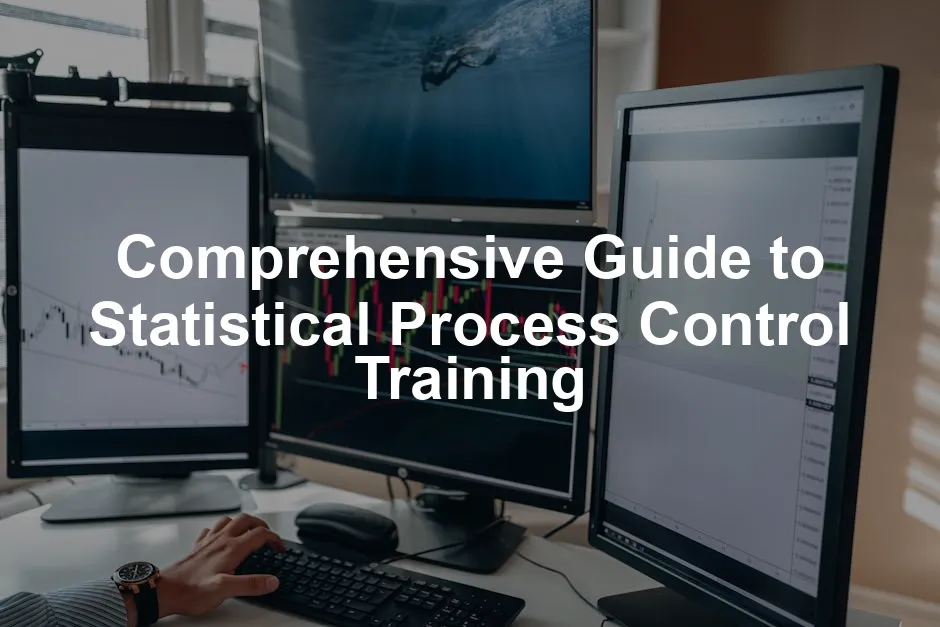Introduction
Statistical Process Control (SPC) is not just a fancy term thrown around in manufacturing meetings. It’s an essential method used to monitor and control processes through statistical analyses. Think of it as the health check-up for your production line. Just like a doctor checks your vital signs, SPC keeps an eye on process performance to ensure everything runs smoothly.
In the realm of quality management, SPC is significant. It helps identify variations in processes, distinguishing between those that are normal and those that are not. This distinction is crucial. By understanding these variations, organizations can take corrective actions before tiny issues snowball into full-blown disasters.
Now, why is SPC training important? Picture this: you’re a quality engineer, and your job is to ensure products meet specified standards. Without proper training, you might miss critical signals that indicate process instability. That’s where SPC training comes in. It equips professionals with the tools and knowledge to implement SPC effectively, ensuring higher quality outputs and less waste. To dive deeper into quality management, consider checking out The Lean Six Sigma Pocket Toolbook. It’s a quick reference guide that will have you improving quality and speed in no time!
Throughout this article, you’ll find a comprehensive overview of SPC training. We’ll explain its core principles, delve into key concepts, and highlight the importance of mastering this skill set. By the end, you’ll understand why SPC training is a vital investment for professionals in manufacturing and process improvement.

Understanding Statistical Process Control (SPC)
What is SPC?
Statistical Process Control (SPC) is the application of statistical methods to monitor and control a process. Essentially, it’s like having a guardian angel for your production line. SPC utilizes control charts, sampling techniques, and other statistical tools to track variations in processes over time.
The primary goal of SPC is to ensure that a process operates efficiently and produces products that meet quality standards. By analyzing data collected from the process, professionals can identify trends, detect anomalies, and make informed decisions. This proactive approach helps in maintaining consistent quality and avoiding costly errors. For those venturing into data analysis, I recommend Data Analysis with R: A Practical Guide for Beginners. It’s a fantastic starting point!

Key Concepts in SPC
In SPC, understanding variation is key. There are two main types of variation: common causes and special causes. Common causes are inherent to the process and are usually stable. On the other hand, special causes arise from specific, identifiable factors that can lead to fluctuations. Knowing the difference is crucial because it dictates how you respond.
Next, let’s talk about control limits versus specification limits. Control limits are statistical boundaries derived from the process itself. They help determine if a process is in control. Specification limits, however, are defined by customer requirements or standards. A process might be in control but still fail to meet specifications, leading to potential dissatisfaction. To help visualize this, consider using Control Chart Templates that can simplify the process!
Lastly, we have process capability. This refers to the ability of a process to produce output that meets specifications. It’s measured using indices like Cp and Cpk, which indicate how well a process can perform within its limits. Understanding process capability is vital for any professional looking to enhance quality and efficiency.
With these concepts under your belt, you’re well on your way to mastering Statistical Process Control. Stick around as we delve deeper into the importance of SPC training and its various components!

Importance of SPC Training
Why Invest in SPC Training?
Statistical Process Control (SPC) training is a ticket to quality nirvana for organizations. Imagine a workplace where defects are rare, waste is minimal, and processes flow smoother than a fresh jar of Skippy. That’s the magic of SPC! Investing in SPC training can transform a mediocre production line into a well-oiled machine.
First off, let’s talk about quality. SPC training equips employees with the tools to monitor and analyze process variations. When teams understand how to detect and interpret variations, they can prevent defects before they occur. This proactive approach means higher quality products, which leads to happier customers. And we all know that happy customers are like unicorns; they’re rare, but when they appear, they bring joy and magic! To further enhance your understanding of quality, check out Quality Control for Dummies.
Next, let’s consider waste reduction. Waste is the enemy of efficiency. It’s like that one friend who always eats the last slice of pizza—nobody wants that! SPC training helps teams identify sources of waste and implement controls to reduce it. By minimizing waste, organizations can save money, improve profitability, and allocate resources more effectively.
But wait, there’s more! SPC training also plays a crucial role in preventing costly errors during production. Picture this: a machine starts producing faulty parts. Without SPC training, operators might not notice the trend until it’s too late. This could result in scrapped products, lost time, and even penalties from dissatisfied customers. With SPC training, employees learn to set control limits and respond to signals that indicate a potential issue. They become the vigilant guardians of quality, ensuring that production runs smoothly and efficiently. If you’re looking for a comprehensive guide on quality management systems, consider The New Quality Management System: A Practical Guide to ISO 9001:2015.
In summary, investing in SPC training is a no-brainer. It leads to improved quality, reduced waste, and the prevention of costly errors. No organization can afford to overlook these benefits. So, if you’re still wondering whether SPC training is worth it, just remember this: Quality equals profit, and profit equals success!
For more insights on how data analysis can enhance your understanding of SPC, check out this article on tips for effective data analysis in economics and statistics.

Target Audience for SPC Training
So, who exactly should attend SPC training? The answer is simple: anyone involved in quality control, manufacturing, or process improvement. This includes quality engineers, production supervisors, and even data analysts. If you’re in a role where you help make products and processes better, this training is for you!
Now, let’s talk prerequisites. While you don’t need to be a statistical wizard, a basic understanding of statistical concepts is beneficial. This can include familiarity with graphs, averages, and basic probability. If numbers make your head spin, fear not! Most training programs cater to various skill levels, ensuring everyone walks away with valuable insights.
Quality managers and process improvement specialists will also find SPC training invaluable. They’ll benefit from learning how to interpret control charts and apply process capability analysis to their respective roles. By understanding SPC principles, they can lead their teams more effectively and drive continuous improvement initiatives. To further enhance your skills, consider picking up The Goal: A Process of Ongoing Improvement. It’s a fantastic read!
In essence, SPC training is for anyone committed to enhancing quality and process efficiency. If you want to be at the forefront of quality management, grab your calculator and sign up! After all, in the world of SPC, knowledge is power. And who doesn’t want a little more power in their professional toolkit?

Control Charts
Control charts are the backbone of Statistical Process Control (SPC). They help monitor process stability over time. There are several types of control charts, including X-bar, R-chart, and p-chart. Each serves a unique purpose.
X-bar charts track the average of a process over time. They are great for monitoring the mean of a sample. The R-chart accompanies the X-bar chart, focusing on the range of variation within the sample. They work together, giving a complete view of the process. If you’re looking for software to help with control charts, consider checking out Control Chart Software that can simplify the process!
Then there’s the p-chart, which handles attribute data. It’s used for tracking the proportion of defective items in a process. This is perfect for quality control, especially when you’re dealing with pass/fail outcomes.
Constructing control charts involves several steps. First, collect data on your process over time. Next, calculate the control limits. These limits are usually set at three standard deviations from the mean. Once you have your chart, plot your data points and analyze them. Look for trends or points that fall outside the control limits. These signals indicate that something might be amiss.
Interpreting control charts requires a keen eye. Are there any patterns? Does the process seem stable? If data points wander outside the limits, it’s time to investigate. This proactive approach can prevent minor issues from becoming major headaches.

Process Capability Analysis
Process capability indices, namely Cp and Cpk, are essential in assessing how well a process meets specifications. Cp measures the potential capability of a process, while Cpk considers both the process mean and its spread. Understanding these indices can help identify how capable your process is in producing items that meet quality standards. If you’re looking for a comprehensive guide on statistical methods, consider Statistical Quality Control: A Modern Introduction.
To assess process performance, conduct capability studies. This involves collecting data during regular operations and calculating Cp and Cpk. If these indices are above 1.33, your process is generally considered capable. However, if they fall below this threshold, it may signify room for improvement.
Analyzing the results of these studies provides insights into process performance. Use this information to make informed decisions about adjustments or improvements. A robust process capability analysis helps ensure that processes consistently produce quality products, leading to satisfied customers and reduced waste.

Advanced SPC Techniques
Advanced SPC techniques take your quality control efforts to the next level. Specialized charts like CUSUM (Cumulative Sum Control Chart) and EWMA (Exponentially Weighted Moving Average) are crucial for detecting small shifts in processes. CUSUM is particularly useful for monitoring changes over time, while EWMA gives more weight to recent data, making it responsive to trends. If you’re looking for a detailed guide on advanced statistical techniques, consider The Art of Data Science.
Short-run SPC is another advanced technique. It is tailored for processes with limited production runs. This approach helps maintain quality control even when production quantities are small. Industries such as automotive and pharmaceuticals benefit greatly from these methods. By implementing short-run SPC, companies can ensure quality without the overhead of long-term data collection.

Practical Applications of SPC
SPC is not just theory; it has real-world applications across various industries. In the automotive sector, for instance, manufacturers use SPC to monitor assembly lines. By employing control charts, they can quickly identify defects and make adjustments.
In healthcare, SPC plays a vital role in patient care processes. Hospitals track various metrics, from patient wait times to medication errors. Implementing SPC helps improve operational efficiency and ensures higher standards of patient safety. It’s crucial for organizations to have the right tools; consider investing in a Quality Management System Template to streamline your processes!
The impact of SPC on operational efficiency is significant. By reducing variation, organizations can enhance product quality and streamline processes. This leads to fewer defects and higher customer satisfaction. Ultimately, the implementation of SPC is a smart move for any organization looking to thrive in today’s competitive market.

Training Methods and Formats
Types of SPC Training Programs
When it comes to Statistical Process Control (SPC) training, the delivery method can significantly affect the learning experience. Let’s compare three popular formats: in-person, virtual, and online.
In-Person Training
In-person training is like a hearty home-cooked meal—warm, engaging, and full of flavor. Participants get the chance to interact directly with instructors, ask questions, and participate in hands-on activities. This face-to-face interaction fosters a collaborative learning environment. However, it can be a tad inconvenient for those with busy schedules or geographical constraints. Plus, let’s face it—traveling can be a hassle.
Pros:
- Direct interaction with instructors.
- Hands-on learning experiences.
- Immediate feedback and clarification.
Cons:
- Requires travel and time commitment.
- Limited flexibility in scheduling.
- Can be more expensive due to logistics.

Virtual Training
Virtual training is like the best of both worlds—bringing the classroom to your living room! Participants can join live sessions from anywhere with an internet connection. This format combines the benefits of in-person training with the convenience of remote learning. Participants can engage in discussions and interact with instructors in real-time. However, the potential for technical glitches and distractions at home can affect concentration. If you’re looking for a way to enhance your learning experience, consider a Set of Statistical Analysis Software to help you analyze the data more effectively!
Pros:
- Flexibility and convenience.
- Real-time interaction and engagement.
- Cost-effective compared to in-person training.
Cons:
- Technical issues may arise.
- Potential distractions from home.
- Less personal connection than in-person.

Online Training
Online training is the buffet of learning options—it’s all about choice! Participants can access pre-recorded materials at their own pace. This format allows learners to revisit challenging concepts as needed, ensuring they grasp the material fully. However, the lack of direct interaction can leave some feeling isolated, and the self-discipline required can be a hurdle for some. Consider complementing your online learning with a Whiteboard for Process Mapping to visualize your ideas!
Pros:
- Flexibility to learn at one’s own pace.
- Access to a wide variety of resources.
- Cost-effective and time-efficient.
Cons:
- Limited interaction with instructors.
- Requires self-motivation and discipline.
- May lack immediate feedback.
In summary, each training method has its own flavor, catering to different needs and preferences. Choosing the right one depends on individual learning styles and logistical considerations.

Certification and Accreditation
Certification in SPC training is like the cherry on top of a sundae—it’s that extra bit of credibility that can make a significant difference in your career. The certification process typically involves completing an accredited SPC training program and passing an exam that tests your knowledge of SPC principles and techniques.
Recognized certifications carry weight in the industry. They serve as proof that you have the skills and knowledge necessary to effectively implement SPC methodologies. Employers often look for candidates with these certifications when hiring for quality control or process improvement roles. Having a certification can enhance your career prospects and open doors to new opportunities. To prepare for certification, consider using resources like The Everything Guide to Six Sigma.
Moreover, accredited training programs ensure that the education you receive meets industry standards. This means you’ll learn the latest techniques and best practices, keeping you ahead of the curve in a constantly evolving field.
In short, obtaining certification in SPC training is a wise investment. It not only validates your expertise but also boosts your marketability in the competitive job landscape. So, don’t miss the chance to add that shiny certification to your resume!

How to Choose the Right SPC Training Program
Factors to Consider
Choosing the right SPC training program is crucial for maximizing the benefits of your learning experience. Here are some key factors to keep in mind:
Relevance of Training Content
First and foremost, ensure that the training content aligns with your role and responsibilities. Different programs may focus on various aspects of SPC, such as data analysis, control charts, or process capability. If you work in quality assurance, a course emphasizing control charts and process improvement will be invaluable. Conversely, if your role involves data analysis, look for a program that covers statistical methods in depth tailored to your needs. To gain a solid understanding of these concepts, consider picking up Statistics for Business and Economics.
Instructor Expertise
The instructor’s expertise is another critical factor. An experienced trainer with a solid background in SPC can provide valuable insights and practical examples. Look for programs led by industry professionals or certified trainers with a track record of success. Their knowledge can help clarify complex concepts and provide real-world applications that enhance your learning experience.
Program Accreditation
Accreditation is vital when selecting an SPC training program. An accredited program ensures that the training meets established industry standards. This validation adds credibility to your learning experience and can be an essential consideration for employers when evaluating your qualifications. Always check whether the program is recognized by relevant professional organizations.
Training Format
Finally, consider the training format that best suits your learning style. Some individuals thrive in interactive environments, making in-person or virtual courses ideal. Others may prefer the flexibility of online training, allowing them to learn at their own pace. Assess your preferences and choose a format that aligns with how you learn best.
By taking these factors into account, you can make an informed decision when selecting an SPC training program that enhances your skills and knowledge, ultimately benefiting your career!

Recommended Training Providers
When it comes to mastering Statistical Process Control (SPC), choosing the right training provider is crucial. Here’s a selection of reputable organizations offering top-notch SPC training to boost your skills and knowledge.
1. Integral Concepts
Integral Concepts offers a robust online SPC training program that spans three days. Participants will gain a solid understanding of SPC fundamentals, control charting, and process capability assessment. Their curriculum covers everything from variation fundamentals to specialized charts, ensuring a comprehensive learning experience. They emphasize practical applications, making the training relevant to real-world manufacturing scenarios.
2. AIAG (Automotive Industry Action Group)
AIAG provides several SPC training options, including live virtual classes and e-learning courses. Their programs focus on integrating SPC with Measurement Systems Analysis (MSA), delivering a thorough understanding of both concepts. They also offer certification options that validate your proficiency in SPC techniques, adding value to your professional profile.
3. BSI Group
BSI Group’s SPC training course caters to professionals seeking a comprehensive understanding of SPC principles. Spanning two days, the course covers control charts, process capability, and data collection methods. BSI also provides both in-person and virtual classroom formats, allowing flexibility in training delivery.
4. Quality Support Group
Quality Support Group hosts a virtual SPC training event aimed at monitoring and controlling processes. Their program focuses on practical applications of SPC, ensuring participants can apply techniques effectively in their workplaces. It’s an excellent option for those looking to improve their process control skills.
5. 6 Sigma
6 Sigma offers an online Introduction to Statistical Process Control program. This course is designed for those new to SPC, covering essential topics like types of process variation and control charts. The format includes quizzes and a certification upon completion, making it an engaging and rewarding experience. If you want to dive deeper into business process management, consider checking out Business Process Management Software.
These providers offer a mix of formats, from hands-on workshops to online courses, catering to various learning preferences. Whether you’re just starting out or looking to deepen your understanding of SPC, these organizations have you covered.

FAQs
What is the duration of SPC training?
SPC training durations vary based on the provider and format. Typical courses last between one to three days. Some online programs allow for self-paced learning, while others are conducted in real-time over several sessions.
What prior knowledge is required for SPC training?
Most SPC training programs do not require extensive statistical knowledge. Familiarity with basic statistical concepts can be helpful, but many courses cater to beginners. They often start with foundational topics to ensure all participants can follow along.
How can SPC training benefit my organization?
The return on investment (ROI) from SPC training is substantial. Organizations that implement SPC can see improved product quality, reduced operational costs, and enhanced customer satisfaction. Employees equipped with SPC skills can identify inefficiencies and correct them proactively, leading to long-term benefits.
What certification options are available after training?
Various certification options exist following SPC training. Organizations like AIAG and Quality America offer certifications that validate your expertise in SPC principles and applications. These credentials can enhance your professional profile and boost career prospects.
Are there online options for SPC training?
Yes, many training providers offer online SPC courses. These programs typically include interactive elements and can be completed at your own pace. Online training is effective and convenient, making it easy to fit learning into busy schedules.
Please let us know what you think about our content by leaving a comment down below!
Thank you for reading till here 🙂
All images from Pexels




